Ubud
Ubud is often considered the cultural heartbeat of Bali, renowned for its rich artistic heritage and lush landscapes. Nestled among sweeping rice paddies and steep ravines in the central foothills of the Gianyar regency, Ubud is markedly different from the beach towns of Bali’s coast. Here’s a deeper look at what makes Ubud a must-visit destination:
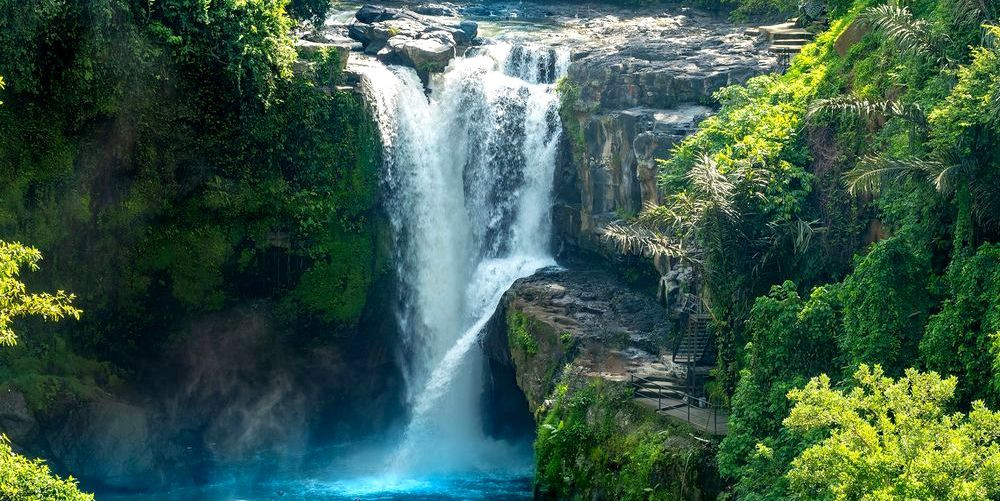
-
Art and Culture: Ubud has long been a haven for local and international artists, inspired by the natural beauty and tranquility of its surroundings. This cultural influence is evident in the myriad art galleries and craft shops that line its streets, offering everything from intricate silver jewelry to hand-painted batik fabrics. The town is also home to museums like the Blanco Renaissance Museum and Agung Rai Museum of Art, which showcase both traditional and contemporary works.
-
Nature and Scenery: The landscape around Ubud is characterized by lush terraced rice fields that climb up the hillsides and are irrigated by an ancient system of water temples and channels. The Campuhan Ridge Walk is a popular spot for visitors looking to enjoy a leisurely hike with picturesque views of this rural Balinese scenery. Additionally, the sacred Monkey Forest Sanctuary is a natural forest home to a troop of grey long-tailed macaques, where visitors can observe the monkeys in their natural habitat.
-
Spiritual Wellness: Ubud is a center for spiritual wellness and yoga, attracting practitioners from around the world. Numerous retreats and studios offer classes and workshops in yoga, meditation, and holistic healing, helping visitors reconnect with themselves in peaceful settings.
-
Culinary Delights: Ubud’s culinary scene is as diverse as its culture, featuring a mix of traditional Balinese cuisine and international dishes. The town is particularly known for its organic, vegan, and health-conscious cafes that source local ingredients. Restaurants like Locavore, which features an innovative, locally sourced menu, have put Ubud on the map for food enthusiasts.
-
Accommodations: From quaint guesthouses nestled in the rice fields to luxurious five-star resorts, Ubud offers accommodations to suit a range of preferences and budgets. Many of these places emphasize relaxation and rejuvenation, incorporating elements like spa services, infinity pools, and lush gardens.
-
Cultural Experiences: Ubud is also a hub for traditional Balinese culture, with daily performances of dance and music. The Ubud Palace in the town center is a popular venue for witnessing the iconic Legong and Kecak dance performances, offering insights into the island’s rich traditions and storytelling.
Ubud's combination of cultural richness, natural beauty, and a serene atmosphere makes it an essential stop for any traveler to Bali looking to experience the island's soul beyond its beaches. Whether you're an art lover, foodie, nature enthusiast, or yoga practitioner, Ubud has something to enchant and engage you.
Seminyak
Seminyak stands out as one of Bali's most stylish and upscale locales, a vibrant destination that blends the charm of Balinese culture with the sophistication of modern amenities. Located on the island's southwest coast, just north of Kuta and Legian, Seminyak is famed for its posh accommodations, high-end shopping, world-class restaurants, and lively nightlife. Here’s a closer look at what makes Seminyak a captivating choice for travelers:
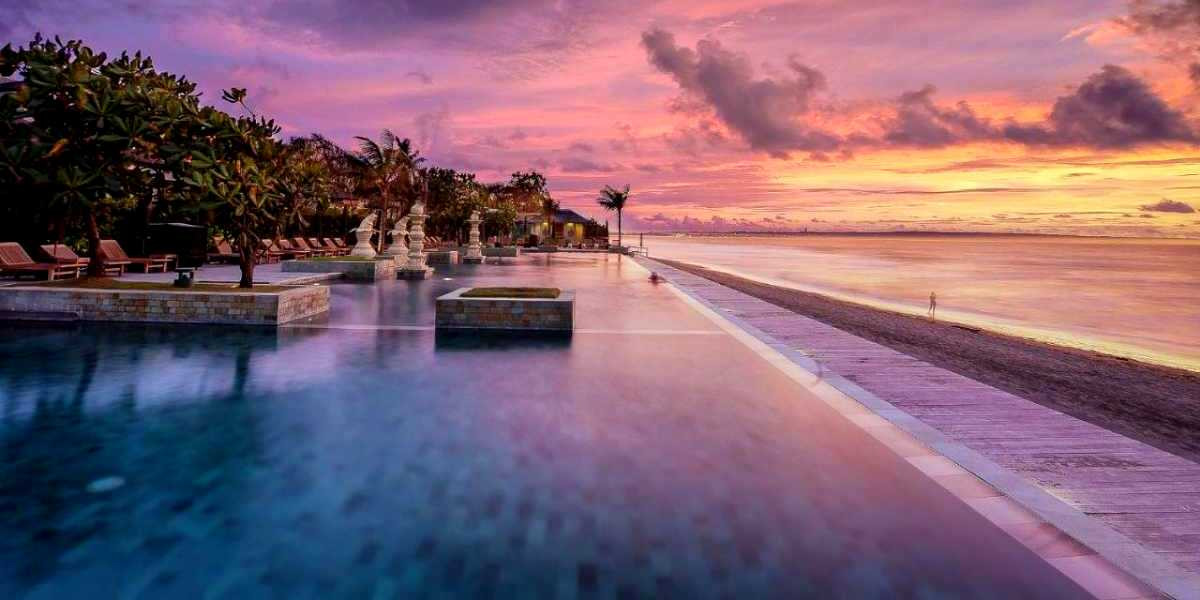
-
Beaches: Seminyak Beach is one of the area's main attractions, known for its expansive stretch of golden sand, spectacular sunsets, and great surf. It's an excellent spot for those looking to indulge in sunbathing, swimming, or surfing. The beach is also lined with trendy beach clubs like Potato Head and Ku De Ta, which offer visitors the perfect setting to sip cocktails, enjoy gourmet meals, and relax to the beats of international DJs as the sun goes down.
-
Shopping: Seminyak is arguably the shopping capital of Bali, with streets lined with boutique stores selling high-end fashion, designer labels, and bespoke handicrafts. Areas like Jalan Raya Seminyak and Jalan Laksmana are bustling with shops offering everything from luxury goods to traditional artifacts, making it a shopper’s paradise.
-
Dining and Nightlife: The dining scene in Seminyak is among the best in Bali, catering to varied palates with a range of cuisine from around the globe. Restaurants like MÉTIS and Sarong are renowned for their innovative dishes that blend local flavors with international culinary techniques. As the sun sets, Seminyak's nightlife comes alive with a host of chic bars, clubs, and lounges offering diverse entertainment options, from live music and DJs to cultural shows.
-
Luxury Accommodations: Seminyak boasts a wide array of luxury hotels, private villas, and spa resorts, offering top-tier amenities and impeccable service. These accommodations are designed to provide an oasis of comfort and tranquility, often featuring private pools, spa services, and direct beach access.
-
Cultural Attractions: Despite its modern flair, Seminyak still offers a taste of Balinese culture with several temples and cultural sites. The Petitenget Temple, right near the beach, is an important cultural landmark and often hosts traditional ceremonies and festivals which visitors are welcome to observe.
-
Wellness and Spa: Seminyak is also known for its sophisticated wellness and spa facilities. Many resorts and independent establishments offer treatments that range from traditional Balinese massages to advanced therapeutic techniques, all designed to rejuvenate the body and spirit.
-
Accessibility: Its proximity to Bali’s Ngurah Rai International Airport and other major areas like Kuta and Nusa Dua makes Seminyak a convenient base for exploring the rest of the island.
Seminyak's blend of beachfront beauty, upscale lifestyle, and cultural richness makes it an ideal destination for those looking to enjoy the finer aspects of Bali's vibrant life. Whether it's luxury shopping, fine dining, or just relaxing in a chic atmosphere, Seminyak offers a cosmopolitan slice of paradise on the island’s southwest coast.
Nusa Penida
Nusa Penida is a rugged, spectacular island located southeast of Bali, known for its dramatic landscapes, crystal-clear waters, and stunning coastal cliffs. This island has gained popularity as a must-visit destination for those looking to explore an untouched part of Bali that offers breathtaking natural beauty and a sense of adventure. Here’s what makes Nusa Penida a unique and thrilling place to visit:
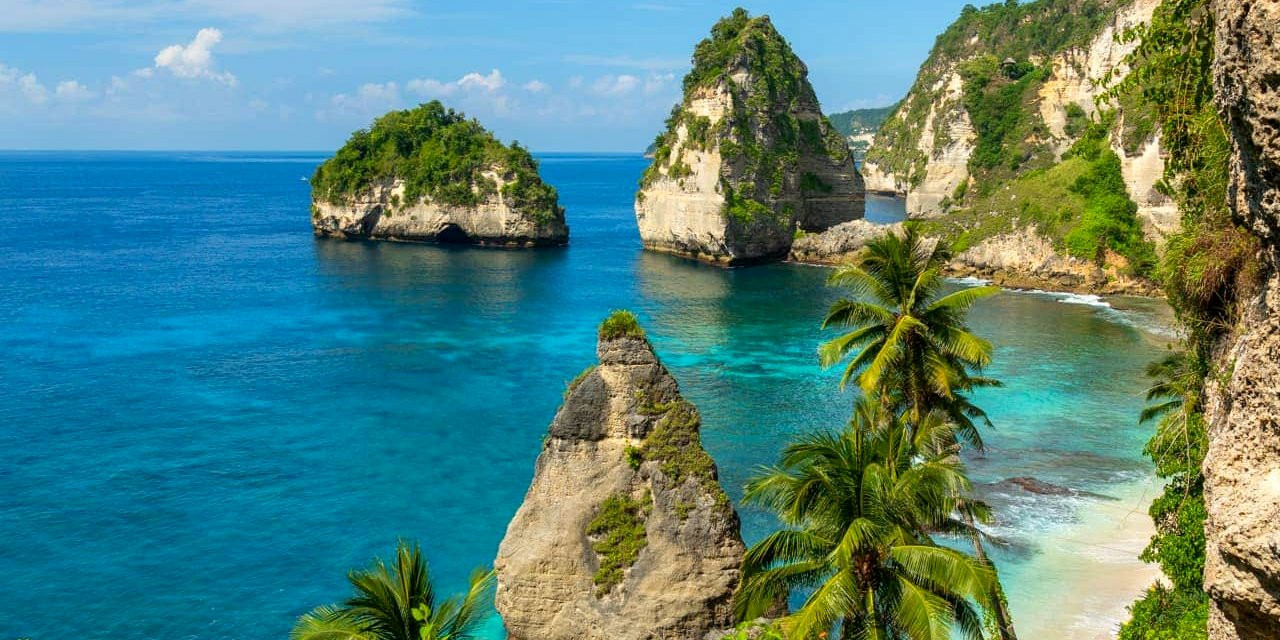
Natural Attractions
Nusa Penida is home to some of the most iconic landmarks and natural attractions in Indonesia. The island is renowned for its majestic views and extraordinary sites like:
-
Kelingking Beach: Known for its T-rex shaped cliff face overlooking a pristine, white sandy beach surrounded by turquoise waters. The view from the top is postcard-perfect, though the trek down to the beach is steep and challenging.
-
Angel’s Billabong and Broken Beach: These two adjacent attractions offer stunning natural beauty. Angel’s Billabong is a natural infinity pool framed by rock cliffs, offering a surreal swim spot during low tide. Broken Beach is famous for its archway that circles the water, creating a unique natural bridge and an incredible photographic spot.
-
Crystal Bay: Known for its crystal-clear waters and sandy beach, it’s a popular spot for snorkeling and diving, with a vibrant coral reef just offshore.
Adventure and Activities: Nusa Penida is a haven for adventure seekers. The island’s rugged terrain and remote trails offer excellent opportunities for hiking and exploring. Diving and snorkeling are spectacular here, with healthy coral reefs and marine life, including the chance to see manta rays at Manta Point.
Cultural Experience: The island is dotted with temples and local villages where traditional Balinese culture is more intact than in the tourist-heavy areas of Bali. Visiting Nusa Penida provides a glimpse into the rural Balinese way of life, which revolves around fishing, seaweed farming, and temple ceremonies.
Tranquility: Unlike its neighboring islands, Nusa Lembongan and Nusa Ceningan, Nusa Penida remains less developed, offering a more tranquil and secluded atmosphere. This makes it an ideal destination for those looking to escape the hustle and bustle of Bali’s more tourist-centric spots.
Challenges and Considerations: Traveling around Nusa Penida can be challenging due to its less developed infrastructure. The roads are often narrow and rough, which makes exploring by scooter or car an adventure in itself. Visitors should be prepared for a more rugged experience and consider hiring a local guide or driver for safety and convenience.
Accommodations: While Nusa Penida doesn’t have the range of luxury accommodations found in Bali, it offers a variety of guesthouses, bungalows, and smaller hotels that provide a comfortable stay without breaking the bank. These accommodations often offer stunning views of the ocean or the island’s rugged terrain.
Nusa Penida is a paradise for those seeking a day trip adventure or a few days away from the main tourist tracks of Bali. With its spectacular natural beauty, thrilling landscapes, and authentic cultural experiences, Nusa Penida is a compelling destination that promises an unforgettable journey.
Uluwatu Temple
Uluwatu Temple, or Pura Luhur Uluwatu, is one of Bali's most iconic and breathtaking temples. Perched on a steep cliff approximately 70 meters above sea level, this ancient temple offers some of the most spectacular ocean views on the island. Here's what makes Uluwatu Temple a must-visit destination in Bali:
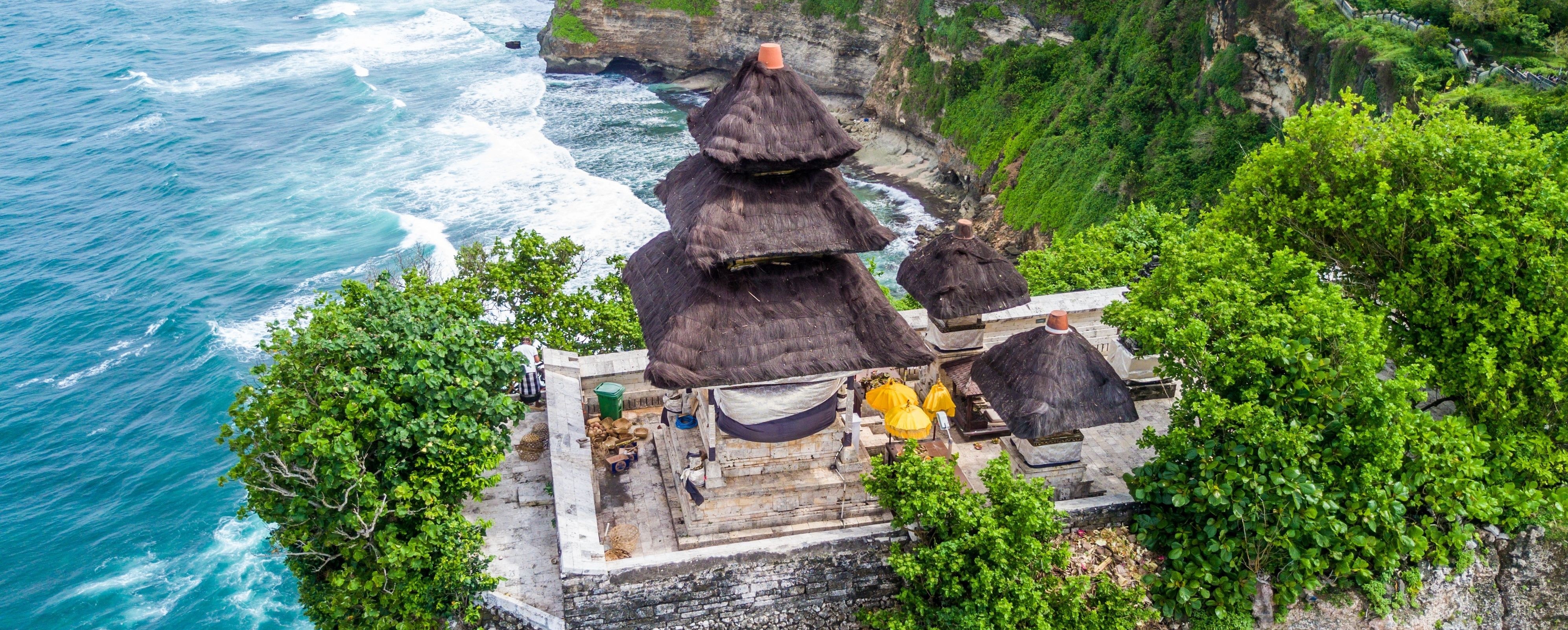
- Stunning Location: The temple stands on the southwestern tip of the Bukit Peninsula, providing panoramic views of the Indian Ocean. The dramatic cliffside location makes it a popular spot for photography and sunset viewings. The sound of the waves crashing against the cliffs below adds to the mystical aura of the temple.
- Cultural Significance: Uluwatu Temple is one of the nine directional temples of Bali, meant to protect the island from evil spirits. The temple is believed to date back to the 10th century, and it is dedicated to Sang Hyang Widhi Wasa in his manifestation as Rudra, the god of elements. The temple plays a significant role in the spiritual life of the Balinese people.
- Kecak Dance Performance: One of the highlights of visiting Uluwatu Temple is watching the traditional Kecak dance performance, which is held at an open-air theater near the temple every evening around sunset. This dance is unique because it does not use any musical instruments but instead relies on a choir of men who provide rhythmic vocal chanting and movements. The dance tells the story of the Ramayana and is set against the backdrop of the setting sun, creating a mesmerizing and unforgettable experience.
- Architectural Beauty: The temple itself is a marvel of traditional Balinese architecture, featuring intricate gateways and ancient sculptures that are meticulously preserved. Visitors can explore different pavilions and courtyards within the temple complex, each offering its unique vantage point over the ocean.
- Wildlife: The area around Uluwatu Temple is also home to a large population of monkeys, who are believed to protect the temple from bad influences. These monkeys are accustomed to visitors and can be quite playful, but it’s important to keep personal belongings secure as they are known to snatch unguarded items.
- Sunset Views: Uluwatu Temple is renowned for its stunning sunsets. Visitors often gather in the late afternoon to find the best spot for watching the sky change colors over the ocean. The combination of the temple's silhouette, the fiery sky, and the sound of the sea makes for a truly magical evening.
Visiting Uluwatu Temple offers not only a glimpse into the spiritual and cultural fabric of Bali but also an opportunity to experience one of the most dramatic and beautiful natural settings on the island. Whether you come for the cultural performances, the architecture, or simply the breathtaking views, Uluwatu Temple is sure to be a highlight of any trip to Bali.
Canggu
Canggu, a coastal village on the south coast of Bali, has rapidly evolved from a quiet surf spot to one of the trendiest areas on the island. Known for its laid-back atmosphere, surf-ready waves, and a vibrant scene that caters to expats, digital nomads, and tourists, Canggu is a blend of bohemian and hipster culture with an authentic Balinese touch. Here's what makes Canggu a must-visit destination:
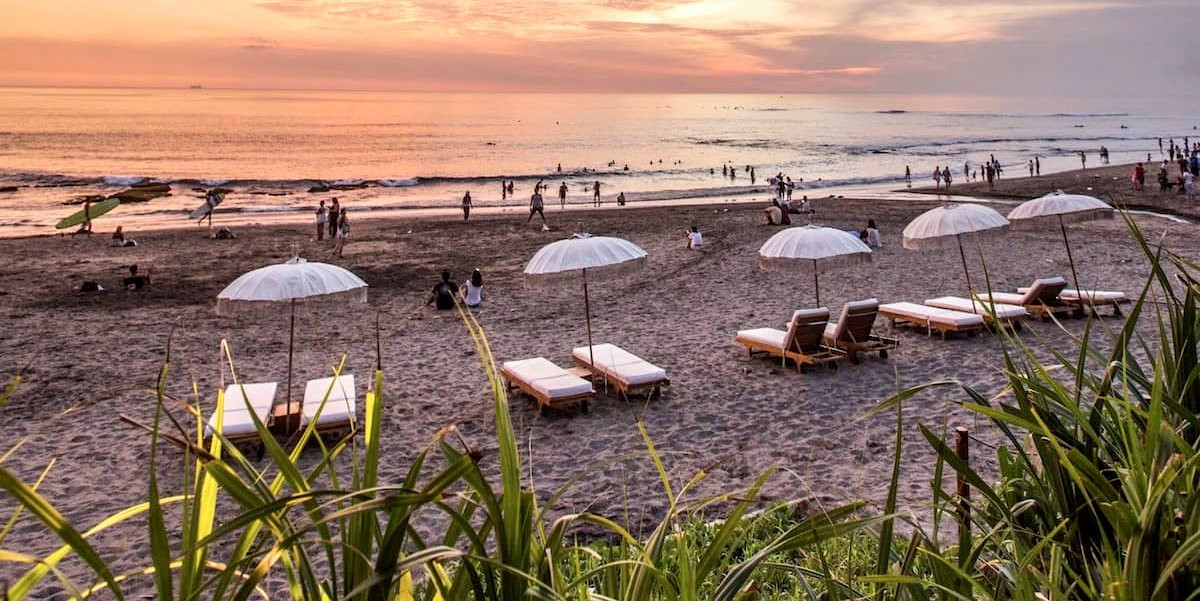
-
Surf and Beach Culture: Canggu's beaches, such as Echo Beach, Batu Bolong, and Berawa, are famous for their great surf breaks which attract surfers from around the world. These beaches are also excellent spots for sunbathing, people watching, and enjoying beautiful sunsets over the Indian Ocean. The laid-back vibe is complemented by beachfront bars and cafes where you can sip a cold drink or enjoy a meal with a view.
-
Trendy Lifestyle: Canggu is renowned for its stylish cafes, boutique shops, and health-conscious restaurants. The area is a hub for creativity, featuring unique designs and concepts that often blend tropical and contemporary aesthetics. You can explore artisan shops selling everything from handcrafted jewelry to custom surfboards and trendy beachwear.
-
Dining and Nightlife: The culinary scene in Canggu is diverse and innovative, catering to all palates and preferences with a strong focus on organic and vegan options. Some popular spots include The Lawn, Old Man’s, and Deus Ex Machina, each offering a mix of delicious food, live music, and vibrant social scenes. The nightlife in Canggu is equally exciting, with numerous bars and clubs hosting regular DJ sets and theme nights.
-
Health and Wellness: Canggu is a center for health and wellness, with numerous yoga studios, wellness retreats, and spas dotted throughout the area. It's a great place to practice yoga, engage in a fitness class, or enjoy a rejuvenating spa treatment using local organic products.
-
Rice Field Scenery: Despite its development, Canggu still retains patches of lush greenery with traditional rice paddies scattered between the residential areas and the coast. These provide a picturesque and peaceful escape from the more bustling parts of Bali. Walking or cycling through these areas offers a glimpse into the traditional agricultural life of the island.
-
Accommodation Options: Canggu offers a wide range of accommodations, from luxury villas and boutique hotels to cozy hostels and private bungalows. Many places feature beautiful pools, tropical gardens, and are often designed with a blend of modern and traditional Balinese architecture.
-
Cultural Insights: While Canggu is modern in many ways, Balinese culture is still very much alive here. You can witness ceremonies and offerings, visit local temples, and interact with the friendly locals who call this area home.
-
Digital Nomad Community: Canggu has emerged as a hotspot for digital nomads, thanks to its coworking spaces that offer high-speed internet alongside a great community vibe. It's a place where work and leisure harmoniously blend against the backdrop of rice fields and surf beaches.
Canggu's unique charm lies in its ability to cater to both those seeking a laid-back beach lifestyle and those desiring a lively social scene. Whether you're looking to catch some waves, explore the local culture, indulge in gastronomic delights, or simply relax in a chic cafe, Canggu offers an idyllic slice of Bali's contemporary paradise.
Pura Tanah Lot
Pura Tanah Lot is one of Bali’s most important landmarks, famed for its unique offshore setting and stunning sunsets. Located on the west coast of Bali, this ancient Hindu temple is perched on a rocky outcrop surrounded by the crashing waves of the open sea. The temple’s iconic silhouette against the vibrant hues of the dusk sky makes it one of the most photographed in Bali. Here’s what you need to know about visiting this sacred site:
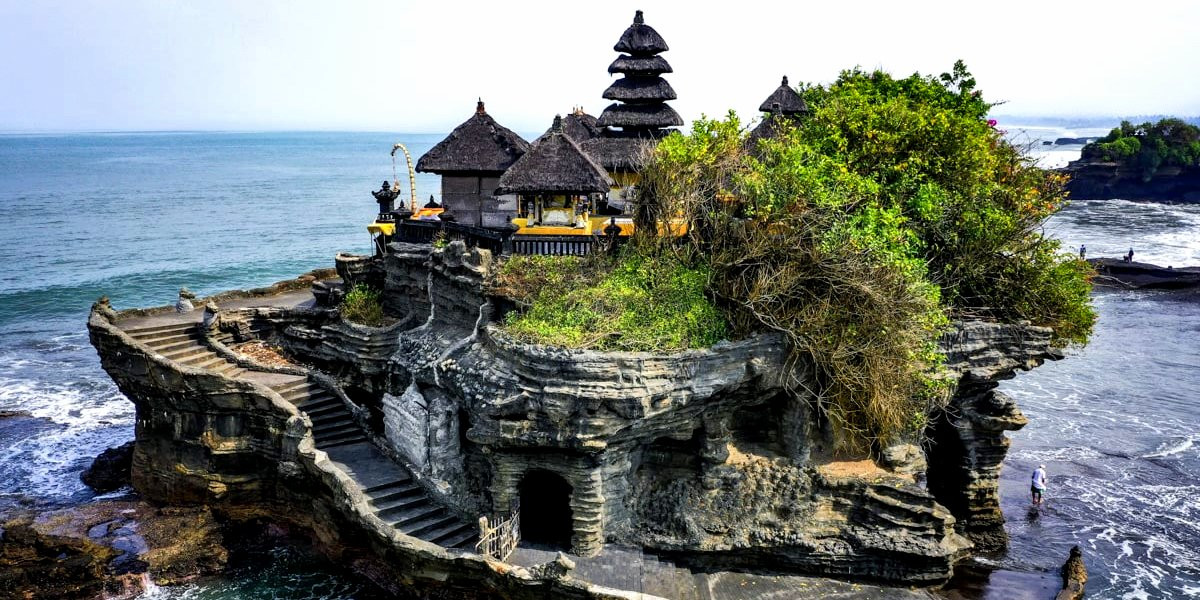
-
Historical and Cultural Significance: Pura Tanah Lot, meaning "Land [in the] Sea" in the Balinese language, plays a vital role in Balinese spiritualism and mythology. It is believed to have been founded in the 16th century by Dang Hyang Nirartha, a revered religious figure in Balinese culture, who is said to have formed the site from the coastal rock and claimed it as a place of worship. Pura Tanah Lot is one of the seven sea temples around the Balinese coast, each within eyesight of the next, forming a chain along the southwestern coast.
-
Architectural Marvel: Although visitors are not allowed to enter the temple grounds itself, the scenic view from various points around the site is more than compensatory. The temple is a stunning piece of traditional Balinese architecture and has significant pilgrimage importance. Over the years, the ocean tide has shaped the base of the rocky island, creating a mesmerizing natural scenery that blends with the spiritual purpose of the temple.
-
Iconic Sunsets: One of the most popular times to visit Pura Tanah Lot is during sunset when the skies and sea glow in vibrant colors, creating a breathtaking backdrop for the temple. This picturesque view draws both locals and tourists alike, making it one of the busiest times at the site.
-
Cultural Experiences: Apart from the temple, the area around Tanah Lot is host to cultural performances, art markets, and souvenir stalls, where visitors can immerse themselves in local crafts and watch traditional Balinese dances. There's also a cultural park where visitors can learn more about Balinese mythology and history.
-
Accessibility and Facilities: The site is well-equipped with tourist facilities, including walkways, shops, restaurants, and sitting areas where visitors can enjoy the view. The pathways leading to the temple can get slippery during high tide, so visitors are advised to watch their step.
-
Environmental and Preservation Efforts: Due to its popularity, the area around Pura Tanah Lot has seen significant tourist activity, which can have a potential impact on its natural and architectural state. Continuous efforts are made to preserve the temple and its surroundings. Visitors are encouraged to respect the natural environment and participate in preservation efforts by adhering to local guidelines.
-
Spiritual and Religious Ceremonies: During low tide, visitors can walk across to the base of the rocky islet. The temple is also an active religious site where ceremonies and rituals are regularly performed. These events provide an excellent opportunity for visitors to observe and experience traditional Balinese religious practices up close.
Visiting Pura Tanah Lot offers more than just a scenic view; it provides insight into the spiritual and cultural fabric of Bali. Whether you're there to capture a perfect sunset or to soak in the spiritual atmosphere, Tanah Lot remains one of the must-visit attractions in Bali, embodying the island’s deep cultural heritage against a dramatic natural setting.
Mount Batur
Mount Batur, located in the central highlands of Bali near Kintamani, is one of the island’s most adventurous attractions. Known for its active volcanic status and the beautiful Batur caldera, Mount Batur offers a unique trekking experience that attracts visitors from around the world. Here’s what makes Mount Batur a standout destination for those visiting Bali:
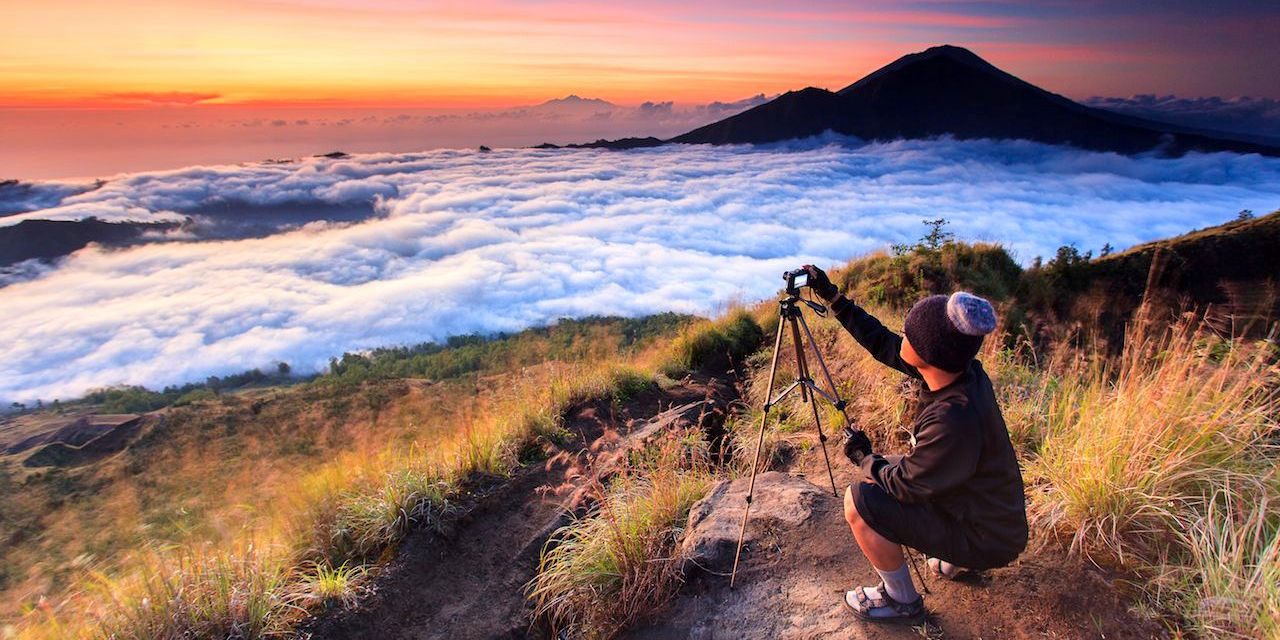
-
Trekking and Sunrise Views: The primary allure of Mount Batur is the trek to its summit, which is most commonly undertaken early in the morning to catch the sunrise. The trek typically starts around 2 or 3 AM, with hikers reaching the summit just in time to witness the spectacular sunrise over the caldera and the surrounding areas. The sight of the sun rising behind Mount Agung and the morning light spilling over the caldera lake is truly breathtaking.
-
Volcanic Landscape: Mount Batur stands at 1,717 meters (about 5,633 feet) above sea level, and the environment near the top is a stark contrast to much of Bali’s lush landscape. The trek involves walking on volcanic ash and rocks, which creates a moon-like terrain with steam vents releasing vapors—a reminder of the mountain's active status.
-
Geological Significance: Mount Batur is an active volcano, having erupted several times in the last century, with the most recent eruptions occurring in the early 2000s. Its constant activity has made it a significant site for geological study and observation.
-
Cultural Importance: The mountain is considered sacred in Balinese culture, with the Batur temple, located on the southwest side of the lake, being one of the key nine directional temples (kayangan jagat) meant to protect Bali from evil spirits. Pilgrimages and religious ceremonies are frequent here, and the local communities hold the mountain in high reverence.
-
Batur Caldera Lake: At the base of Mount Batur is the serene Batur Lake, the largest crater lake on the island of Bali. The lake offers a peaceful contrast to the rigorous climb and is an excellent spot for relaxing after the trek. There are also hot springs nearby where visitors can soothe their muscles in natural mineral waters heated by the volcanic activity beneath the earth.
-
Local Cuisine: Post-trek, many visitors enjoy a traditional Balinese breakfast cooked using the steam from the active volcanic vents, adding a unique element to the Mount Batur experience. The area is also known for its coffee plantations, where you can taste some of the locally grown coffee.
-
Guided Tours: Due to the complexity and potential hazards of trekking an active volcano, it is highly recommended to undertake the climb with a local guide. Guides can provide insights into the history and geology of the mountain, as well as ensure the safety of hikers.
Trekking Mount Batur is an exhilarating challenge that rewards hikers with unforgettable views and a profound sense of accomplishment. It’s an essential Bali experience for adventure seekers looking to capture some of the island’s most stunning natural beauty.
Nusa Lembongan
Nusa Lembongan is a small island located southeast of Bali, part of a trio of islands that includes Nusa Penida and Nusa Ceningan. Known for its laid-back atmosphere, beautiful landscapes, and excellent marine life, Nusa Lembongan is a popular destination for those looking to escape the hustle and bustle of Bali’s more tourist-heavy areas. Here's what makes Nusa Lembongan a special place to visit:
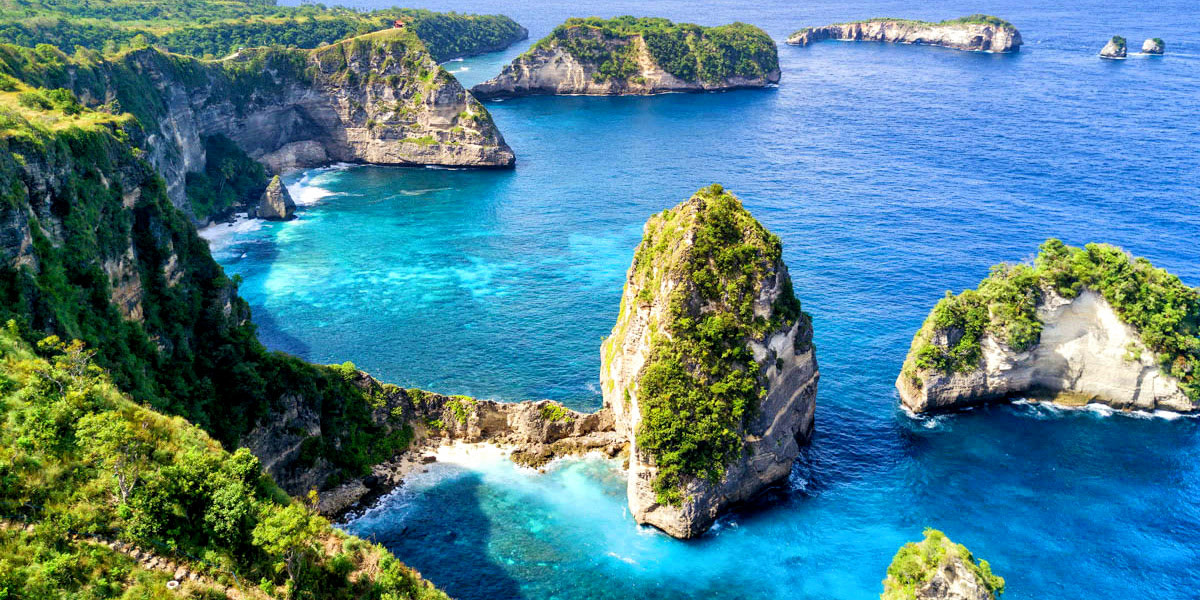
-
Natural Beauty and Tranquility: Nusa Lembongan is considerably smaller and less developed than Bali, which contributes to its tranquil vibe. The island features stunning white sandy beaches, clear blue waters, and beautiful coral reefs. Its size makes it easy to explore by bike or on foot, allowing visitors to enjoy its natural beauty at a leisurely pace.
-
Surfing and Water Sports: The island is a hotspot for surfers, with three main surf breaks: Playgrounds, Lacerations, and Shipwrecks, each offering good waves for different levels of experience. Besides surfing, Nusa Lembongan is also great for other water activities such as snorkeling and diving. The waters around the island are rich in marine life, including colorful coral reefs and a diverse range of fish.
-
Mangrove Forest: The mangrove forest in the north of Nusa Lembongan is a vital ecosystem and can be explored by traditional jukung boats or kayaks. This serene experience allows visitors to glide through the quiet waters under the shade of the mangrove canopy, observing the unique flora and fauna.
-
The Devil’s Tear: A dramatic coastal feature, the Devil’s Tear is a rugged cliff face where waves crash into a rocky cove, creating powerful water plumes and rainbows on sunny days. This spot is perfect for photography and offers spectacular sunset views.
-
Seaweed Farming: Seaweed farming is an important part of the local economy in Nusa Lembongan. The farms, which are visible at low tide, cover large areas of the coast where the seaweed is harvested by local farmers. Visitors can learn about the seaweed farming process and its significance to the community.
-
Accommodation and Dining: Nusa Lembongan offers a range of accommodation options, from luxury resorts to modest bungalows, many of which provide stunning ocean views. The dining scene is equally diverse, featuring everything from traditional Indonesian meals to international cuisine, often featuring freshly caught seafood.
-
Proximity to Sister Islands: The close proximity to Nusa Ceningan and Nusa Penida makes it easy for visitors to island-hop and explore the distinct features of each island. Nusa Ceningan, connected by a yellow bridge, is known for its Blue Lagoon, while Nusa Penida offers even more dramatic landscapes and larger scale attractions.
-
Ideal for Relaxation: With its slow pace and beautiful surroundings, Nusa Lembongan is ideal for those seeking relaxation. Whether it’s through yoga retreats, spa treatments, or simply unwinding on a quiet beach, the island provides a perfect backdrop for rejuvenation.
Nusa Lembongan is a gem of natural beauty and serenity, offering a mix of adventure, relaxation, and insight into traditional lifestyles. It’s an ideal destination for travelers looking to experience the charm of Bali in a more intimate and less crowded setting.
Pura Ulun Danu Bratan
Pura Ulun Danu Bratan, often simply referred to as Ulun Danu Temple, is one of Bali's most picturesque and significant temples. Located on the shores of Lake Bratan in the mountains near Bedugul, this temple is a major water temple, serving the irrigation needs of the farms and rice paddies that surround it. Here’s what makes Pura Ulun Danu Bratan a captivating destination:
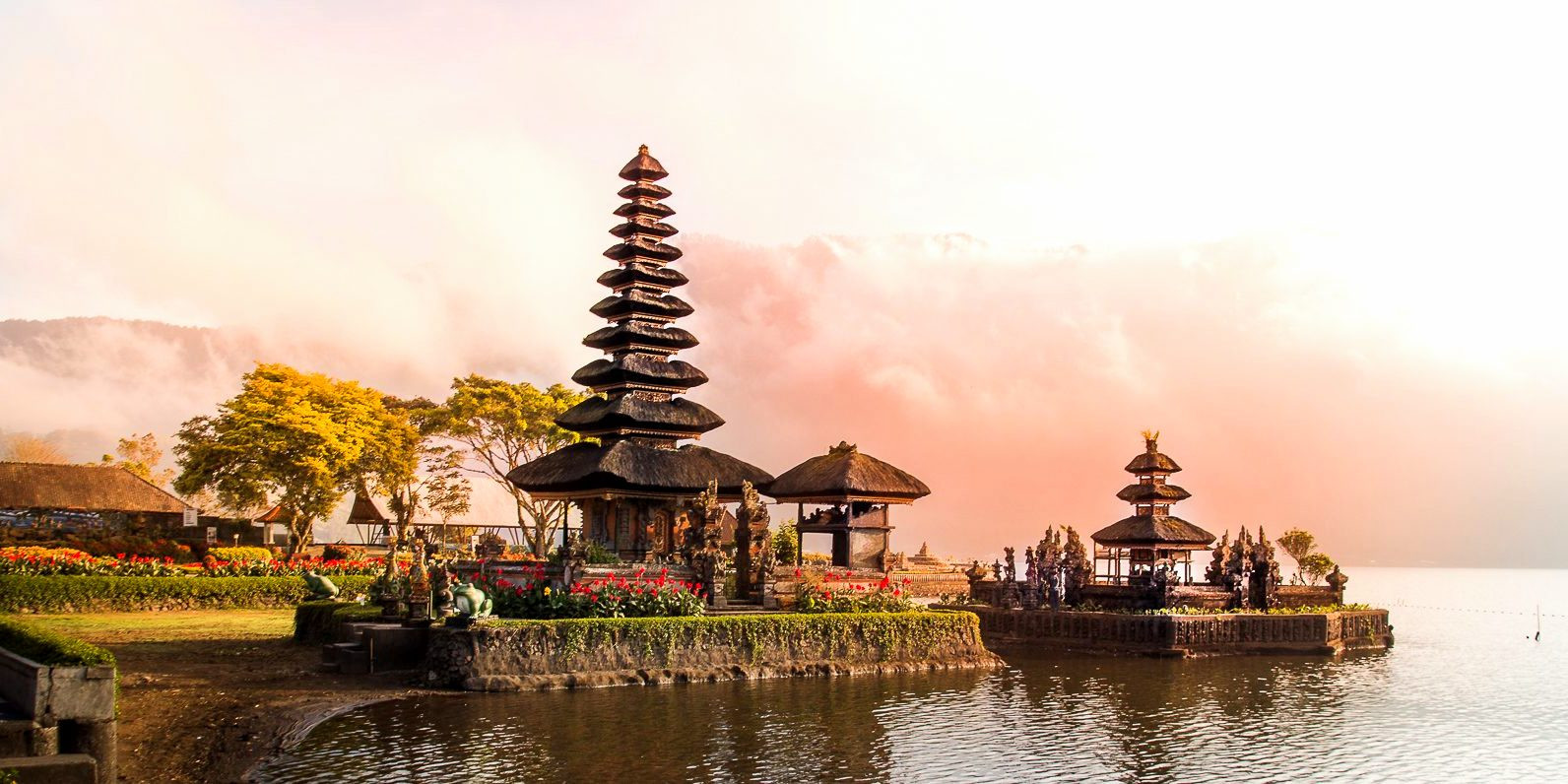
-
Stunning Location and Architecture: The temple complex is situated in the cool highlands of central Bali at an elevation of about 1,200 meters, offering a refreshing escape from the island’s tropical heat. The setting of the temple on the western shore of Lake Bratan creates a reflective illusion that it is floating on the water, especially when the lake's water levels are high. The temple’s architecture is a blend of Hindu and Buddhist elements, and it features several shrines dedicated to different deities.
-
Historical Significance: Built in the 17th century, Pura Ulun Danu Bratan is dedicated to Dewi Danu, the goddess of lakes and rivers. "Ulun Danu" literally translates to "head of the lake," which underscores the temple's importance in Balinese culture and religion as a site of offerings and ceremonies dedicated to this deity, ensuring a balanced and continued water supply.
-
Cultural Importance: The temple is one of Bali’s iconic landmarks and a vital element of the subak irrigation system, which is a UNESCO World Heritage site. The Balinese depend heavily on their ability to manage and share water resources, and Pura Ulun Danu Bratan plays a central role in this water management system.
-
Lush Gardens and Scenic Beauty: Surrounding the temple are beautifully maintained gardens with an abundance of tropical flowers and manicured lawns, which are often enveloped in a light mist, adding to the mystical and serene atmosphere of the place. The cool climate and lush backdrop make it a popular spot not just for tourists but for locals seeking a peaceful day out.
-
Photography and Recreation: Thanks to its scenic location and beautiful structures, Pura Ulun Danu Bratan is a favorite among photographers. Visitors can also rent boats to explore Lake Bratan or simply enjoy the tranquility of the lake and its surrounding mountains.
-
Festivals and Ceremonies: Various religious ceremonies and festivals are held at the temple throughout the year, providing visitors with an opportunity to witness Balinese culture in its most vibrant form. These events are especially colorful and are a major draw for culturally inclined travelers.
-
Accessibility: Pura Ulun Danu Bratan is accessible by road and is a major stop on most northern Bali tours. It is about a 90-minute drive from many of Bali’s major southern tourist areas, making it an easy day trip for those staying in places like Ubud or Kuta.
Visiting Pura Ulun Danu Bratan offers not only a glimpse into the spiritual life of Bali but also provides a chance to enjoy some of the most beautiful landscapes that the island has to offer. Its unique blend of natural beauty, cultural significance, and historical architecture makes it a must-visit for anyone traveling to Bali.
Tegenungan Waterfall
Tegenungan Waterfall is one of Bali's most popular and accessible waterfalls, located near Ubud in the village of Tegenungan, within the Kemenuh district. Unlike many other waterfalls in Bali that are situated in the highlands or deep within tropical forests, Tegenungan is just a short drive from Ubud and is not situated at a high altitude, making it a convenient stop for those who do not wish to undertake a long trek. Here's what makes Tegenungan Waterfall a notable destination:
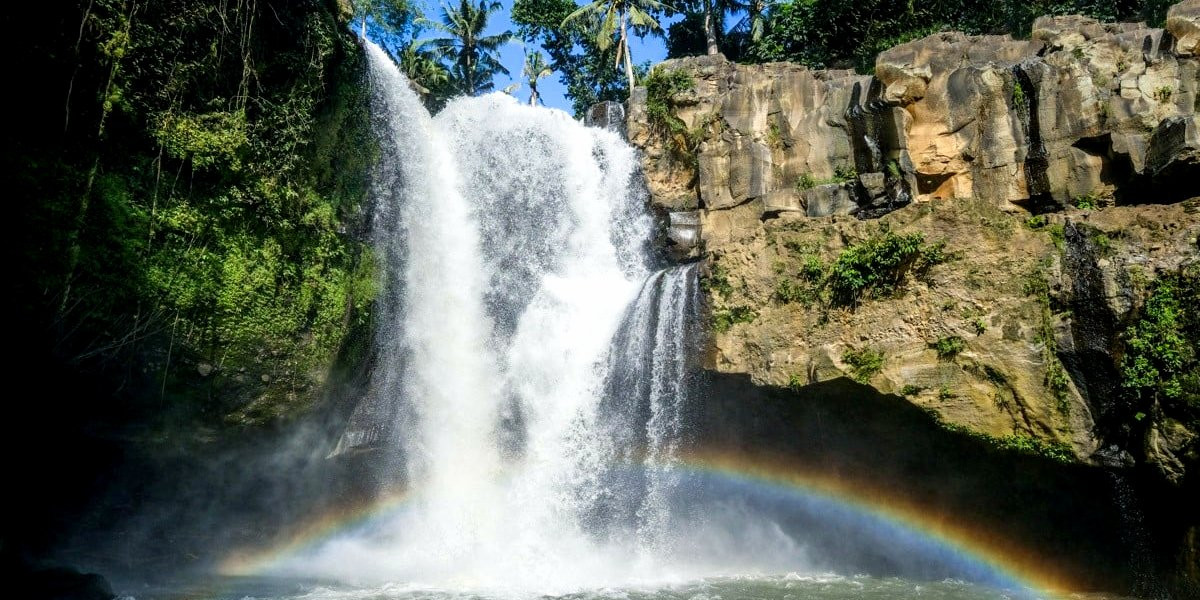
-
Stunning Natural Beauty: Tegenungan Waterfall is a powerful cascade that falls over a rocky cliff into a cool, natural swimming pool below. The waterfall is about 25 meters high and offers a dramatic view, especially during the wet season when the water flow is at its peak. The surrounding greenery and the natural pool provide a picturesque setting perfect for swimming and relaxation.
-
Accessibility: One of the major draws of Tegenungan Waterfall is its accessibility. The waterfall is easily reachable by car or scooter, and there's a well-maintained pathway with steps leading down to the waterfall, making it accessible for most visitors without the need for a strenuous hike. This accessibility makes it a popular choice for families and those who are looking for a quick and rewarding visit to one of Bali’s natural attractions.
-
Amenities and Activities: The site has developed significantly over the years to cater to tourists. There are several viewing platforms, cafes, and souvenir shops near the waterfall. For those looking for a bit more adventure, it is also possible to climb onto the rocks or take a dip in the refreshing waters of the river.
-
Photography: Tegenungan Waterfall is a favorite spot for photographers, thanks to its grandeur and the lush tropical backdrop. Early morning or late afternoon are the best times to capture the waterfall with natural lighting and to avoid the crowds that can gather during the day.
-
Cultural Aspect: While Tegenungan is primarily visited for its natural beauty, the area is also significant for its proximity to local Balinese villages, which gives visitors a glimpse into the everyday lives of local people. The waterfall itself plays a role in the spiritual life of the community, and visitors will often see offerings or ceremonies taking place.
-
Environmental Considerations: As with many popular tourist sites, the increase in visitors has put pressure on the natural environment around Tegenungan Waterfall. Efforts are being made to manage tourism sustainably. Visitors are encouraged to respect the natural beauty by avoiding littering and adhering to local guidelines.
Tegenungan Waterfall is an excellent option for those looking to experience one of Bali’s beautiful waterfalls without venturing too far from the main tourist centers. Its beauty and accessibility make it a worthwhile addition to any Bali itinerary, offering both a place for relaxation and a chance to capture some of Bali's spectacular natural scenery.
Kuta Beach
Kuta Beach is one of the most famous and bustling beaches in Bali, located on the island's southwestern coast near the Ngurah Rai International Airport. Known for its long, sandy stretch and lively atmosphere, Kuta Beach has been a favorite among tourists for decades, especially those looking for vibrant nightlife, extensive shopping, and a variety of activities. Here’s what makes Kuta Beach a highlight for many visitors to Bali:
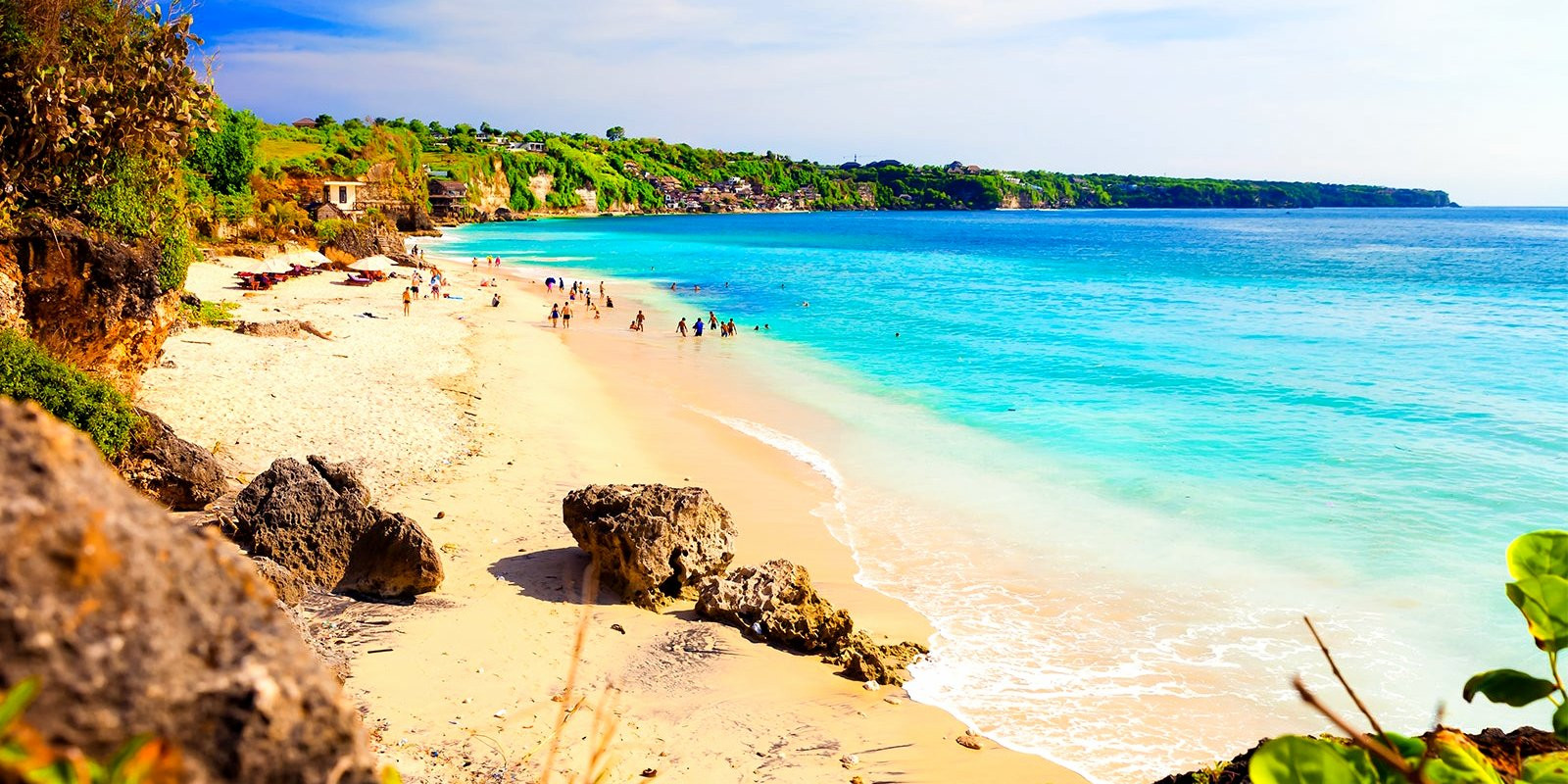
-
Surfing and Beach Activities: Kuta Beach is renowned for its surf-friendly waves, making it a popular spot for both beginner and intermediate surfers. The beach offers numerous surf schools where newcomers can learn the basics of surfing. Besides surfing, the beach is ideal for sunbathing, playing beach soccer, and enjoying scenic walks along the coast.
-
Accessibility and Facilities: One of the reasons for Kuta’s popularity is its accessibility. It is easily reachable from any part of Kuta and neighboring areas like Legian and Seminyak. The beach is well-equipped with amenities such as sun loungers, umbrellas for rent, and showers. Lifeguards are also present to ensure the safety of swimmers and surfers.
-
Nightlife and Entertainment: Kuta Beach is at the heart of Bali’s nightlife scene. The area is teeming with clubs, bars, and restaurants that cater to a diverse crowd. Iconic nightlife spots like Sky Garden and Hard Rock Café offer everything from live music and DJs to themed party nights, attracting a lively young crowd.
-
Shopping: Adjacent to the beach, visitors will find a plethora of shopping options ranging from street vendors selling local handicrafts to fashion outlets and large shopping malls like Beachwalk. This makes Kuta an excellent place for those looking to combine a beach day with some shopping.
-
Family-Friendly Attractions: Beyond the beach itself, Kuta offers various family-friendly attractions such as Waterbom Bali, one of Asia’s top water parks, providing fun and entertainment for all ages. Additionally, the Discovery Shopping Mall and Kuta Art Market offer more relaxed entertainment options suitable for families.
-
Cultural Events: Despite its modern and tourist-centric facade, Kuta still offers glimpses into traditional Balinese culture with occasional cultural performances and ceremonies taking place on the beach, especially during special occasions like Nyepi (Balinese Day of Silence) and Kuta Karnival.
-
Accommodation: Kuta Beach area boasts a wide range of accommodation options, from luxury hotels and resorts to budget-friendly guesthouses. This variety makes Kuta an accessible choice for all types of travelers.
-
Challenges: It's worth noting that Kuta Beach can become very crowded, and its popularity has led to some issues with cleanliness and commercialization. Visitors are encouraged to be mindful of their environmental impact and choose sustainable activities and services where possible.
Kuta Beach offers a dynamic mix of activities, entertainment, and dining options, making it a quintessential stop for many tourists in Bali. Whether you're looking to catch your first wave, dance the night away, or simply soak up the vibrant atmosphere, Kuta Beach has something for everyone.
Sanur Beach
Sanur Beach, located on the southeastern coast of Bali, offers a stark contrast to the bustling Kuta. Known for its laid-back atmosphere, Sanur is a favorite among families and older travelers who prefer a quieter beach experience. Here's what makes Sanur Beach a charming destination:
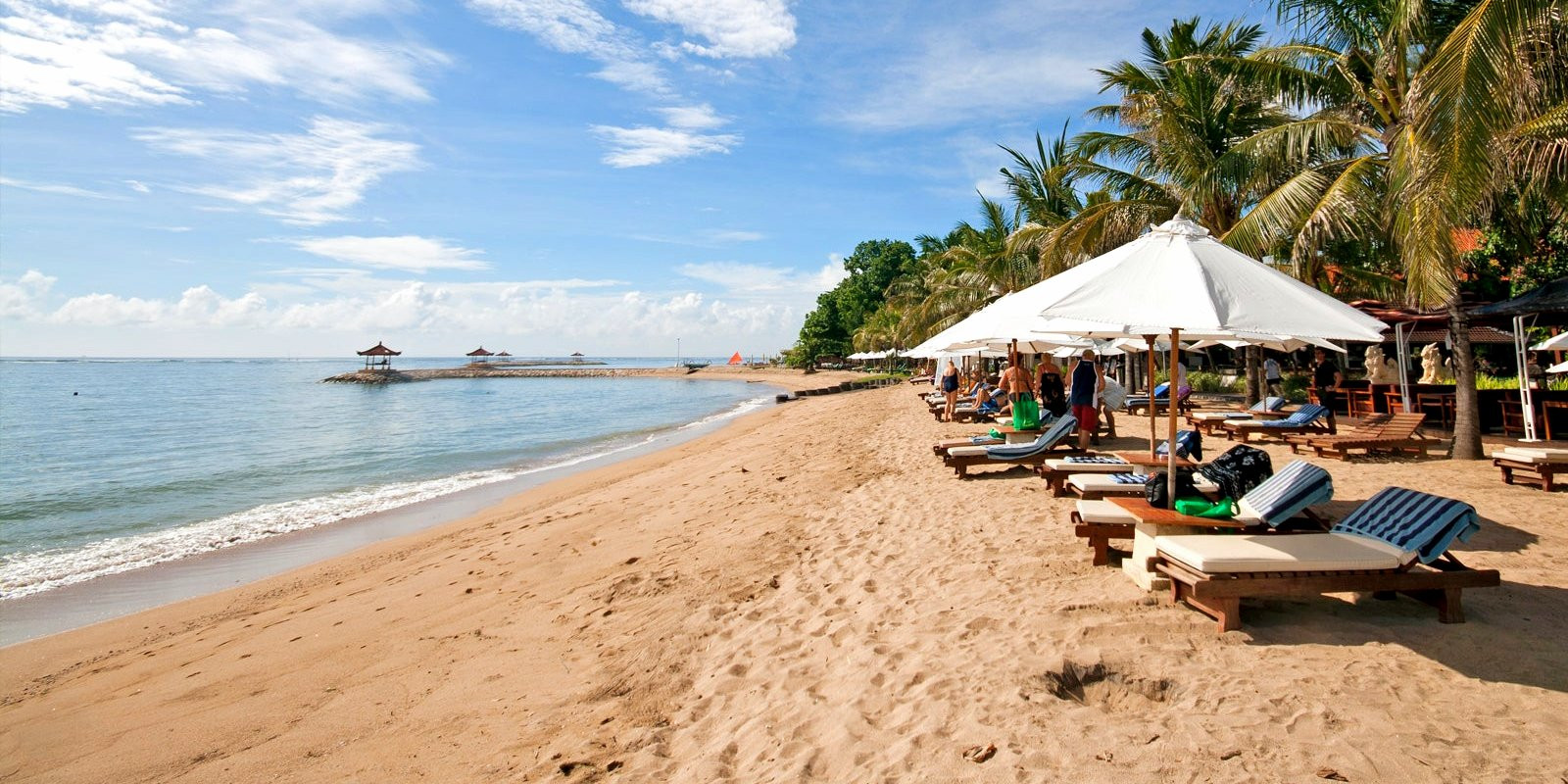
-
Tranquil Atmosphere: Sanur's ambiance is far more relaxed compared to Bali's busier west coast beaches. The pace is slower, making it ideal for those who want to unwind and enjoy a peaceful beach day. The beach itself features a long stretch of sandy shoreline with calm, shallow waters protected by a reef, which makes swimming safe for all ages.
-
Cultural Charm: Sanur is one of Bali’s oldest resort areas and has retained much of its traditional village feel. It's common to see local fishermen in their traditional boats and daily offerings at the many temples and shrines along the beach. This cultural presence adds a unique charm to the area, providing a glimpse into the Balinese way of life.
-
Sunrise Views: Unlike the sunset beaches of the west coast, Sanur is famous for its stunning sunrises. The beach faces east, offering early risers a chance to see the sky light up in brilliant colors as the sun rises over the ocean. This makes for a perfect start to the day with a quiet morning walk along the beach.
-
Promenade and Dining: Sanur has a lovely paved beachfront promenade that stretches over 5 kilometers, ideal for walking, jogging, or cycling. Lined with cafes, restaurants, and shops, the promenade is active throughout the day with locals and tourists alike. The dining options along the beach offer a mix of international and local cuisines, with many spots providing beautiful sea views.
-
Water Sports and Activities: Though quieter, Sanur still offers a range of water sports and activities. Traditional jukung boats can be rented for sailing or fishing trips, and the reef just off the coast is a popular spot for snorkeling and diving. Kite surfing is also a popular activity here, especially during the windy season from May to September.
-
Accommodation: Sanur provides a wide array of accommodation options, from luxury resorts to modest homestays. Many of these are located directly on or just steps away from the beach, offering easy access to Sanur's main attractions.
-
Family-Friendly: Sanur is particularly well-suited for families with children. The beach is bordered by a reef, creating lagoon-like conditions that are safe for younger swimmers. Many hotels and restaurants are family-friendly, offering facilities and services tailored to guests with children.
-
Art and Markets: Sanur is also known for its local art scene and markets. The Le Mayeur Museum, which was once the home of Belgian artist Adrien-Jean Le Mayeur, showcases a collection of Balinese art and cultural artifacts. The Sindhu Night Market offers a taste of local street food in a vibrant setting.
-
Accessibility: Sanur is conveniently located, with easy access to Denpasar, Bali’s capital, and the international airport. This makes it a practical base for exploring other parts of Bali.
Sanur Beach's blend of cultural richness, scenic beauty, and tranquil vibe makes it a delightful destination for those seeking a quieter, more laid-back beach experience in Bali. Its appeal lies in its ability to combine relaxation with cultural immersion, making it a standout choice for a serene holiday escape.
Sekumpul Waterfall
Sekumpul Waterfall, often regarded as one of the most beautiful and majestic waterfalls in Bali, is located in the northern part of the island, in the Singaraja region. This stunning natural attraction consists of a cluster of several narrow cascades that form a dramatic backdrop amidst lush tropical greenery. Here’s why Sekumpul Waterfall is a must-visit for nature lovers and adventure seekers:
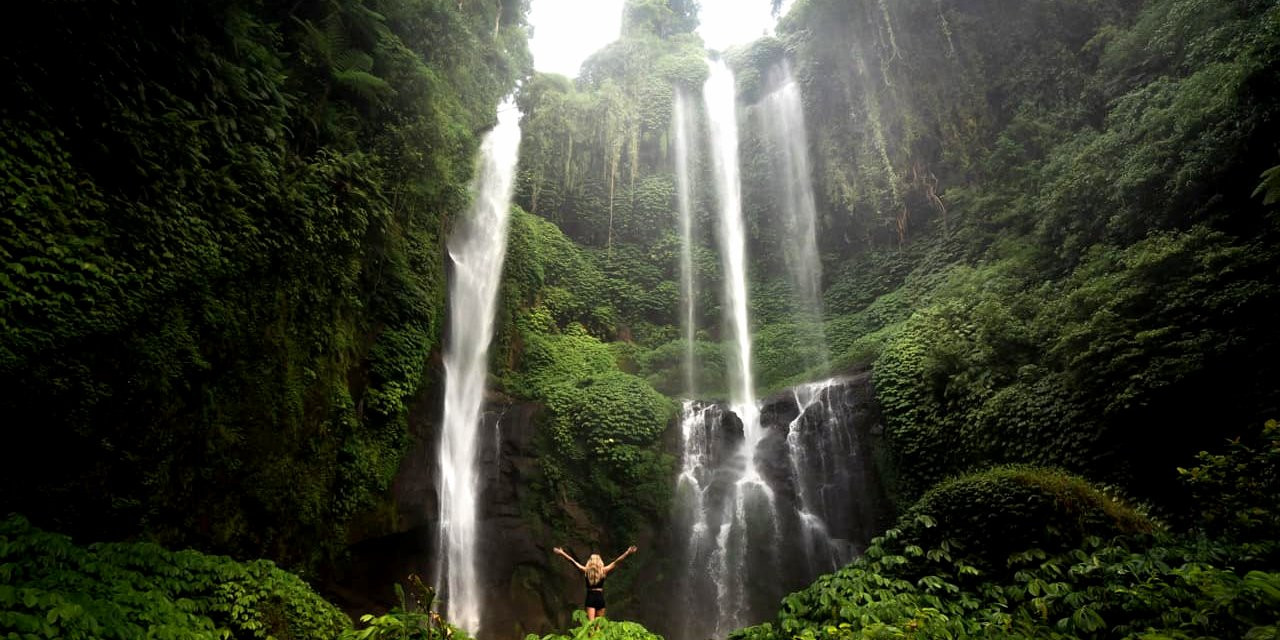
-
Natural Splendor: The waterfalls at Sekumpul, which means "group" in Indonesian, are aptly named as they are actually a group of about seven different falls, each varying in height and shape, hidden deep within a verdant jungle. The main waterfall plummets from a height of about 80 meters (262 feet) and is often enveloped in a light mist, creating a mystical atmosphere that feels like something out of a fairy tale.
-
Adventure and Trekking: Reaching Sekumpul Waterfall involves a bit of adventure, which adds to the appeal for many visitors. The trek to the waterfall is considered moderate to challenging and includes descending steep steps and crossing streams. There are two main routes to the falls — a shorter route that leads directly to the base of the main falls and a longer trek that allows you to view multiple falls from various vantage points. The paths are surrounded by lush tropical vegetation, adding to the scenic and immersive jungle experience.
-
Local Guide Support: It is highly recommended to visit Sekumpul Waterfall with a local guide. Not only do guides provide valuable insights about the area and its natural history, but they also help navigate the somewhat tricky paths and contribute to the local economy. The guides ensure that you find the best spots for photography and safely enjoy the natural pools under the waterfalls.
-
Refreshing Swim: At the base of the main waterfall, there is a large natural pool where visitors can swim and enjoy the cool, fresh water. Swimming here, surrounded by the natural beauty and the sound of cascading water, is an exhilarating experience that many find rejuvenating.
-
Scenic Views: Along the trek, there are several spots where you can stop and enjoy panoramic views of the surrounding hills and the valley in which the waterfalls are located. The lush landscape and the distant sight of multiple waterfalls streaming down the cliffs make for unforgettable scenic vistas.
-
Cultural Insight: The area around Sekumpul is part of a traditional village, where visitors can observe and experience the local way of life. Interaction with the community, including visiting local homes or trying traditional Balinese snacks, can enrich the visit.
Visiting Sekumpul Waterfall is not just a journey to a destination but an immersive experience in Bali’s natural beauty and cultural richness. It offers an adventure that is both physically rewarding and spiritually uplifting, making it a highlight for many travelers exploring the depths of Bali’s natural landscape.
Gunung Kawi
Gunung Kawi is a remarkable archaeological site located in Tampaksiring, northeast of Ubud, Bali. This temple complex, carved into the rock, is one of Bali's oldest and most distinctive monuments, steeped in history and mystique. Here’s what makes Gunung Kawi a captivating destination:
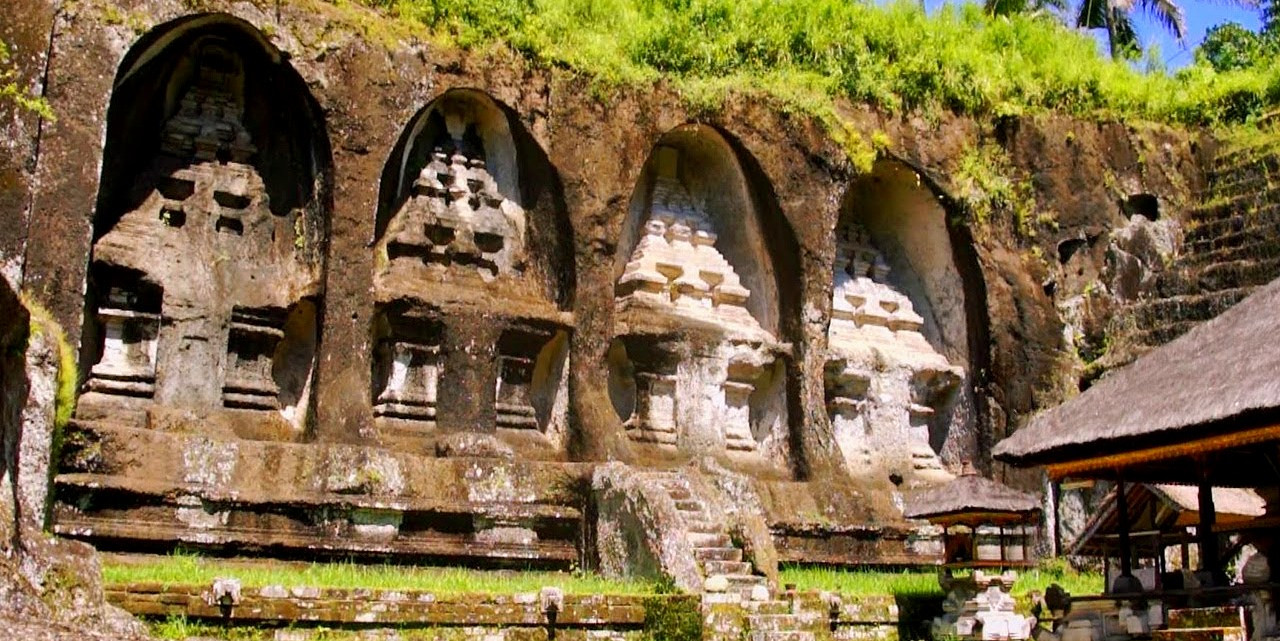
-
Historical Significance: Gunung Kawi consists of ten candi (shrines) carved into the rock face of a steep cliff. Dating back to the 11th century, these shrines are believed to be dedicated to King Anak Wungsu of the Udayana dynasty and his favorite queens. The site exudes a historical aura that transports visitors back in time, offering a glimpse into the island’s rich past.
-
Architectural Marvel: The candi are an impressive sight: enormous and majestic, they stand about 7 meters (23 feet) high, hewn directly out of the rock in imitation of actual statues. They are designed to resemble the entrance to a Hindu temple, featuring intricate and stylized reliefs that highlight the artistry and craftsmanship of their creators.
-
Spiritual and Cultural Atmosphere: Gunung Kawi is considered a sacred place. It is still used for religious ceremonies and pilgrimages, adding a profound spiritual dimension to visits. The atmosphere is serene and contemplative, enhanced by the sound of the Pakerisan River flowing through the complex. Visitors are often struck by the peacefulness and mystical quality of the site.
-
Natural Setting: The temple complex is set in a lush green valley with paddy fields, coconut trees, and thick foliage surrounding the area, which enhances the mystical and ancient feel of the site. The approach to Gunung Kawi involves descending a flight of more than 300 steps, offering picturesque views and a refreshing connection with nature.
-
Art and Culture: Apart from the main shrines, the site features several ancient and medieval sculptures and carvings in the rock, some of which depict mythological scenes and stories. These artworks provide insight into the cultural and religious life of Bali centuries ago.
Gunung Kawi offers not only a historical and cultural journey but also a spiritual experience. Its combination of stunning natural beauty, architectural grandeur, and serene spirituality makes it a must-visit for those interested in Bali's rich heritage. This site provides a quieter, more contemplative counterpoint to the island’s beachside attractions, making it a profound addition to any Bali itinerary.
Nusa Dua
Nusa Dua, located on the eastern coast of Bali's southern peninsula, is a meticulously planned and well-maintained area known for its luxury resorts, pristine beaches, and upscale facilities. This enclave of exclusivity and comfort is designed primarily for tourism, making it a popular choice for travelers seeking a more refined and serene Bali experience. Here's what makes Nusa Dua a standout destination:

-
Luxury Resorts and Accommodations: Nusa Dua is home to a collection of high-end resorts and hotels that offer top-notch amenities, including private beaches, sumptuous spas, gourmet restaurants, and world-class service. These establishments are designed to provide a complete and luxurious holiday experience within their expansive and beautifully landscaped grounds.
-
Pristine Beaches: The beaches in Nusa Dua are among the cleanest and most beautiful in Bali. The white sandy shores and clear, calm waters create a perfect setting for swimming, sunbathing, and water sports. The protective coral reefs make the waters particularly calm, making them ideal for families with children.
-
Water Sports and Activities: Nusa Dua’s beaches offer a wide array of water sports, such as snorkeling, diving, jet skiing, parasailing, and banana boat rides. The area is also known for its well-equipped water sports centers, which provide lessons and equipment for all skill levels.
-
Golfing: For golf enthusiasts, Nusa Dua offers an internationally renowned golf course—The Bali National Golf Club. This beautifully landscaped course provides a challenging yet enjoyable experience for golfers, with stunning views and impeccable fairways and greens.
-
Cultural Shows and Events: Nusa Dua is not just about leisure and relaxation; it also hosts various cultural performances, exhibitions, and international conferences. The Bali Nusa Dua Theatre features spectacular shows like Devdan, which showcases the rich cultures of Indonesia's various islands.
-
Shopping and Dining: The Bali Collection is Nusa Dua’s main shopping, dining, and entertainment complex, offering a wide range of restaurants, cafes, and shops. The area provides an array of dining options that cater to international tastes as well as traditional Indonesian cuisines.
-
Well-Planned Infrastructure: Nusa Dua’s infrastructure is designed to ensure that visitors have a seamless and comfortable experience. The area is well-maintained with clean streets, beautiful landscaping, and a layout that promotes easy accessibility to all amenities and attractions.
-
Peace and Order: Security in Nusa Dua is taken very seriously, with checkpoints and private security ensuring a safe environment for all visitors. This makes Nusa Dua one of the safest areas in Bali, appealing particularly to luxury travelers and those seeking peace of mind during their vacation.
-
Accessibility: Nusa Dua is conveniently located about 20 minutes from Ngurah Rai International Airport, making it easily accessible for international travelers. It also serves as a great base for exploring other areas of Bali.
Nusa Dua's blend of luxury, cleanliness, and organization makes it an ideal destination for those who wish to enjoy a premium, hassle-free holiday experience. Its tranquil beaches, superior accommodations, and variety of recreational activities provide a complete resort experience that caters to families, couples, and solo travelers alike.
Tips for Best Place to Visit in Bali
When planning a trip to Bali, it's essential to consider a variety of factors to make the most of your visit. Here are some valuable tips for exploring Bali and enjoying what the island has to offer effectively:
Choose the Right Time to Visit: Bali is a year-round destination, but the best time to visit is during the dry season, from April to October. The weather is less humid, and there's less rainfall, making it ideal for beach activities, hiking, and sightseeing. The wet season, from November to March, offers lush landscapes and fewer crowds but expect frequent rains.
Plan According to Your Interests
Bali offers a diverse range of activities and sights:
-
For beach lovers and surfers: Visit Kuta, Seminyak, and Uluwatu for their famous beaches and surf breaks.
-
For cultural enthusiasts: Explore Ubud for its art galleries, traditional dances, and temples.
-
For nature and adventure seekers: Trek to Mount Batur, visit the Sekumpul Waterfall, or explore the natural beauty of Nusa Penida.
-
For luxury and relaxation: Nusa Dua and Sanur offer upscale resorts, spas, and serene beaches.
Respect Local Customs and Traditions: Balinese culture is deeply rooted in Hinduism, which shapes the daily life of its people. Dress modestly, especially when visiting temples (cover shoulders and knees, and wear a sarong). Also, be respectful during religious ceremonies and ask permission before taking photos.
Try Local Cuisine: Bali offers a rich culinary experience. Don't miss out on traditional dishes like Babi Guling (suckling pig), Bebek Betutu (slow-cooked duck), and various types of sate. Also, explore local warungs (small family-owned restaurants) for authentic and inexpensive meals.
Stay Safe and Healthy
-
Stay hydrated and use sunscreen, especially if you spend a lot of time outdoors.
-
Be cautious with street food to avoid stomach upsets. Drink bottled water only.
-
Follow local health and safety guidelines, especially when engaging in water sports or other adventure activities.
Use Local Transportation Wisely: While renting a scooter is a popular and convenient way to get around, it's not for everyone due to Bali's often chaotic traffic. Consider hiring a driver for day trips, which can be more relaxing and safer. For shorter distances, use apps like Gojek or Grab for affordable rides.
Explore Beyond the Tourist Traps: While Bali’s popular spots are worth visiting, don't hesitate to venture off the beaten path. Visit the quieter northeastern coast, the scenic rice terraces in Jatiluwih, and the traditional villages in Karangasem.
Bargain Wisely: In local markets and street shops, bargaining is expected. However, do it respectfully and with a smile. It's part of the local shopping experience and can be fun when done right.
Mind Your Environmental Footprint: Bali struggles with plastic waste. Help by reducing your plastic usage—carry a reusable water bottle, avoid plastic straws, and take your shopping bag. Respect the natural sites by not littering and adhering to eco-friendly practices.
Stay Connected: Consider buying a local SIM card for easy access to maps, information, and emergency contacts while exploring Bali. They're affordable and can be recharged easily.
Following these tips can help ensure a memorable and enjoyable visit to Bali, allowing you to appreciate its natural beauty, rich culture, and warm hospitality more fully.
Ideal Time for Place to Visit in Bali
Choosing the ideal time to visit Bali largely depends on your preferences for weather, crowd levels, and the types of activities you plan to enjoy. Here's a breakdown to help you decide when to plan your trip:
Dry Season (April to October)
-
Weather: This is the dry season in Bali, featuring sunny days and minimal rainfall, making it the best time for outdoor activities like beach days, surfing, and hiking. The weather is generally cooler and less humid, particularly from June to September.
-
Crowds: July and August are the peak tourist months, coinciding with European and North American summer holidays, so expect larger crowds and higher prices. If you prefer a quieter visit with fewer tourists but still great weather, consider April, May, September, or October.
-
Activities: The dry season is ideal for diving, snorkeling, and other water sports, as the sea conditions are typically calmer and clearer. It's also a great time for cultural festivals, such as the Bali Arts Festival in June and Independence Day celebrations in August.
Wet Season (November to March)
-
Weather: Known as the monsoon season, this period features higher humidity and heavy rains, particularly in December and January. The rains are usually intense but short, often occurring in the late afternoon or overnight, leaving sunny mornings and early afternoons.
-
Crowds: Tourist numbers drop during these months, which can be advantageous if you're looking for less crowded attractions and lower accommodation rates.
-
Activities: The lush landscapes are at their most vibrant during the wet season, making it a perfect time for photographers and nature enthusiasts. The waterfalls are especially impressive, full of water and surrounded by rich greenery. It’s also a good time for cultural immersion, as you can experience the local pace of life without the crowds.
Shoulder Seasons
- Transition Months: March and November are transition months, where the weather shifts between the dry and wet seasons. These months can offer a mix of both weather patterns and are less predictable, but can also mean fewer tourists and more reasonable prices.
For the best overall weather and activity options, April to June and September to October are ideal times to visit Bali. These months offer a good balance of pleasant weather, manageable tourist levels, and lower prices, providing a more relaxed experience. If you don't mind occasional rain and are interested in lush landscapes and local culture without the crowds, consider visiting during the wet season.
With a top destination for visitors from all over the world, Bali presents a unique mix of natural beauty, cultural wealth, and exciting activities. Every part of Bali offers distinctive sights—from the dynamic Kuta beaches to the calm Ubud temples. Bali offers something for everyone, whether you&'re looking for leisure on sandy shores, cultural immersion in native customs, or the excitement of outdoor sports. Your vacation in Bali will be an amazing experience given careful preparation and appreciation of its customs and surroundings.
FAQs for Best Place to Visit in Bali
Q: What is the best time to visit Bali?
A: The best time to visit Bali is during the dry season from April to September when the weather is sunny and suitable for outdoor activities. For fewer crowds and lower prices, consider visiting during the shoulder months of April and September.
Q: Which part of Bali is best for families?
A: Nusa Dua and Sanur are ideal for families due to their calm beaches, family-friendly resorts, and overall quieter atmosphere.
Q: Where should I stay in Bali for the first time?
A: Seminyak is a great choice for first-timers looking to explore Bali, offering a mix of beaches, restaurants, shops, and nightlife. Ubud is another excellent option if you prefer a more cultural and serene environment.
Q: What are the must-visit attractions in Bali?
A: Key attractions include Ubud for its rice terraces and cultural activities; Uluwatu Temple for its cliffside views and cultural performances; and Nusa Penida for its stunning coastal cliffs and marine life.
Q: What are some hidden gems in Bali?
A: Sekumpul Waterfall for its breathtaking natural beauty and less crowded experience, the traditional village of Penglipuran, and the less-traveled east coast, including Amed and Sidemen, for a more authentic Balinese experience.
Q: How many days are sufficient to explore Bali?
A: Ideally, a minimum of one week allows you to explore a variety of landscapes and attractions in Bali, but extending to two weeks would enable a deeper exploration of the island, including leisure time and travel between different regions.
Q: Is Bali safe for tourists?
A: Yes, Bali is generally safe for tourists. However, practice common travel safety tips such as safeguarding your belongings, respecting local customs, and being cautious with food and water.
Q: What should I pack for a trip to Bali?
A: Pack light, breathable clothing, a good pair of walking shoes, swimwear, sunblock, a hat, and sunglasses. Also, consider bringing a raincoat if you're visiting during the wet season.
Q: Are there any cultural norms or etiquette I should be aware of?
A: Yes, dress modestly when visiting temples, always use your right hand for giving or receiving items, and remove your shoes before entering someone's home or a temple. Be mindful not to point your feet at people or sacred objects as it's considered disrespectful.
Q: What is the best way to get around Bali?
A: Renting a scooter is a popular and convenient way for those comfortable with driving. Alternatively, hiring a driver or using app-based taxi services like Gojek or Grab can offer a more relaxed and efficient way to explore the island.
For the Nepal tour, please click here.
If you are looking for different kinds of Nepal Tours or Trekking Packages, feel free to contact us.
















